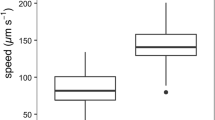Abstract
A unicellular organism, Paramecium, exhibits circadian rhythm activities in many physiological phenomena, i.e., mating reactivity, photoaccumulation in Paramecium bursaria and mating type reversals in Paramecium multimicronucleatum. In this study, we used an image-processing system to analyze swimming activity in a population of Paramecium multimicronucleatum cultured axenically under 12 h-light/12 h-dark cycles (LD 12∶12). Swimming behavior was recorded both under LD 12∶12 and constant darkness and images tracing the tracks of Paramecium were produced every 4 min. Swimming activity was represented by the occupied area by the tracks relative to the total observed area. It is high during daytime and low at night and exhibits a freerunning rhythm in constant darkness. Furthermore, criteria for two major components of swimming behavior, straight and circle swimming, were established and analyzed. The results indicate that swimming behavior alters depending on the time of day: straight swimming increased during the day and circling was dominant around dusk both under LD 12∶12 and constant darkness.
Similar content being viewed by others
Abbreviations
- ZT :
-
Zeitgeber Time
- LD 12∶12 :
-
12h- light/12h-dark cycles
- TF :
-
transversing frequency
References
Eckert R (1972) Bioelectric control of ciliary activity. Science 176: 473–481
Ehret CF (1953) An analysis of the role of electromagnetic radiation in mating reaction of Paramecium bursaria. Physiol Zool 26: 274–300
Fok AK, Allen RD (1979) Axenic Paramecium caudatum I. Mass culture and structure. J Protozool 26: 463–470
Hall JC (1991) Cycling transcripts and the circadian clock. Current Biology 1: 89–90
Hasegawa K, Tanakadate A (1984) Circadian rhythm of locomotor behavior: its characteristics as derived from circadian changes in the swimming speed and the frequencies of avoiding response among individual cells. Photochem Photobiol 40: 105–112
Iwatsuki K, Naitoh Y (1983) Behavioral responses in Paramecium multimicronucleatum to visible light. Photochem Photobiol 37: 415–419
Johnson CH, Hastings JW (1986) The elusive mechanism of the circadian clock. Am Sci 74: 29–36
Johnson CH, Miwa I, Kondo T, Hastings JW (1989) Circadian rhythm of photoaccumulation in Paramecium bursaria. J Biol Rhythms 4: 405–415
Kondo T, Strayer CA, Kulkarni RD, Taylor W, Ishiura M, Golden SS, Johnson CH (1993) Circadian rhythms in prokaryotes: luciferase as a reporter of circadian gene expression in Cyanobacteria. Proc Natl Acad Sci USA 90: 5672–5676
Kung C, Saimi Y (1982) The physiological basis of taxis in Paramecium. Annu Rev Physiol 44: 519–534
Machemer H (1989) Cellular behavior modulated by ions: electrophysiological implications. J Protozool 36: 463–487
Miwa I, Nagatoshi H, Horie T (1987) Circadian rhythmicity within the single cell of Paramecium bursaria. J Biol Rhythms 2: 57–64
Naitoh Y, Eckert R (1972) Electrophysiology of ciliate Protozoa. Exp Physiol Biochem 5: 17–31
Naitoh Y, Eckert R (1974) The control of ciliary activity in Protozoa. In: Sleigh MA (ed) Cilia and flagella. Academic Press, London New York, pp 305–352
Nakajima K, Nakaoka Y (1989) Circadian change of photosensitivity in Paramecium bursaria. J Exp Biol 144: 43–51
Nakaoka Y, Kinugawa K, Kurotani T (1987) Ca2+-dependent photoreceptor potential in Paramecium bursaria. J Exp Biol 131: 107–115
Pittendrigh CS (1981) Circadian systems: general perspective. In: Aschoff J (ed) Handbook of behaviorel neurobiology, Vol. 4. Biological Rhythms. Plenum Press, New York
Sweeny BM (1960) The photosynthetic rhythm in single cells of Gonyaulax polyedra. Cold Spring Harbor Symp Quant Biol 25: 145–148
Tanakadate A, Ishikawa H, Hasegawa K (1985) Microcomputerized measurement of the circadian rhythm in microorganisms. Physiol Behav 34: 241–248
Welsh DK, Logothetis DE, Meister M, Reppert SM (1995) Individual neurons dissociated from rat suprachiasmatic nucleus express independently phased circadian firing rhythms. Neuron 14: 697–706
Author information
Authors and Affiliations
Rights and permissions
About this article
Cite this article
Ohata, K., Kano, M., Kishigami, A. et al. Rhythmicity of swimming activity in an axenic population of Paramecium multimicronucleatum . J Comp Physiol A 179, 645–651 (1996). https://doi.org/10.1007/BF00216129
Accepted:
Issue Date:
DOI: https://doi.org/10.1007/BF00216129




